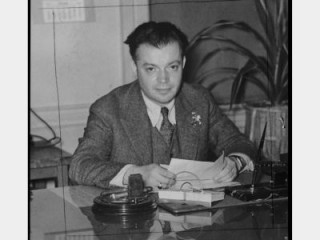
David Dubinsky biography
Date of birth : 1892-02-22
Date of death : 1982-09-17
Birthplace : Brest-Litovsk, Belarus
Nationality : American
Category : Politics
Last modified : 2011-02-17
Credited as : Labor leader, union official,
David Dubinsky was an influential American trade union official. His leadership of the International Ladies' Garment Workers' Union demonstrated his ability to combine the more mundane attributes of the labor movement with the broader social vision of a reformer.
Together with such men as John L. Lewis, Sidney Hillman, and Philip Murray, David Dubinsky built the American labor movement as it now functions. During the Great Depression and the New Deal of the 1930s, through the creation of industrial unions (as opposed to craft unions) in the mass-production industries, these leaders brought trade unionism into a position of power whereby labor influenced big business and national politics.
Dubinsky (originally Dobnievski) was born in Brest-Litovsk in Russian Poland on Feb. 22, 1892, the youngest of six children in a poor Jewish family. His father moved the family to Lodz, where he operated a bakery. At the age of 11, David went to work for his father. By 14 he was a master baker and a member of the Bakers' Union, an affiliate of the Polish Bund, a revolutionary organization of Jewish workers.
Membership in the Bund led to Dubinsky's arrest in 1907 during a wave of Czarist repression following the abortive 1905 Russian Revolution. After a short jail term he returned to union activity, leading a strike by bakers in Lodz, which resulted in another arrest and expulsion to Brest-Litovsk. Dubinsky, however, returned illegally to Lodz and to union affairs, only to be arrested in 1908 and this time sentenced to exile in Siberia.
He was too young to be sent to Siberia, so Dubinsky was jailed in Lodz for a year and a half, until he was old enough to be transported there. On the way to Siberia he escaped and, convinced he had no future within the Russian Empire, decided to emigrate to the New World. In 1911 Dubinsky arrived in the United States.
Within two weeks Dubinsky took out his first papers, joined the Socialist party, and enrolled in night school. He soon became a garment cutter (the most skilled craft in the garment industry) and a member of Local 10, International Ladies' Garment Workers' Union (ILGWU), the union which represented the trade's skilled-labor "aristocrats." At first Dubinsky devoted his time to Socialist party activities and to the Cooperative movement, but after his marriage to Emma Goldberg in 1914 he began to concentrate upon his craft and to take more interest in local union affairs.
Dubinsky spoke for the more recent immigrants in the union, whose increasing numbers assisted his rise to union power. In 1918 he was elected to Local 10's executive board and a year later was vice-president. Elected president in 1920, the following year Dubinsky also became general manager, a full-time, well-paid position that allowed him to leave the cutter's bench. By 1924 he added to his offices the secretary-treasurership of the local, thus becoming the most powerful figure within the New York locals that dominated the ILGWU.
A born pragmatist whose Socialist dreams had died, and eager to rise in the union hierarchy, Dubinsky joined the anti-Communist faction of the ILGWU during the 1920s in the internal war that almost tore the organization apart. With the aid of Dubinsky's powerful Local 10, the anti-Communists triumphed, but the union was wrecked and nearly bankrupt.
A member of the ILGWU's general executive board since 1923, Dubinsky was elected secretary-treasurer in 1929, allowing him to run the union since its president was desperately sick. In 1932 the president died, and Dubinsky replaced him, still retaining his secretary-treasurer's office. Until 1959 he held both positions.
Franklin Roosevelt's election to the U.S. presidency in 1932 offered Dubinsky true opportunity. Taking advantage of New Deal labor legislation, Dubinsky had increased his union's membership to over 200,000 by the end of the next year.
Elected to the American Federation of Labor (AFL) executive council in 1934, Dubinsky supported the industrial unionists' effort to organize mass-production workers. When the AFL refused its assistance, Dubinsky in 1936 resigned from the executive council. He assisted in forming the Committee on Industrial Organization (CIO). Always a firm believer in labor unity, however, when the CIO became a permanent, second national labor federation in 1938, Dubinsky took the ILGWU out. He returned his union to the AFL in 1940 and 5 years later was reelected to the AFL executive council.
During the 1930s Dubinsky broke with socialism, becoming a fervent supporter of Roosevelt's New Deal. He declared, "Trade unionism needs capitalism like a fish needs water." Because New York City's Jewish workers looked with suspicion upon the local Democratic machine, Dubinsky helped create the American Labor party to capture former Socialist voters for the New Deal. When he thought that Communists had taken over the American Labor party, he helped found the Liberal party. By the mid-1940s he was one of the nationally respected leaders of the pro-New Deal, rabidly anti-Communist wing of the American labor movement. In 1947 he helped found Americans for Democratic Action, and independent political organization.
At his retirement from union office in March 1966, Dubinsky left a thriving labor organization, though it was no longer committed to the establishment of a cooperative society. Dubinsky's heritage to the labor movement was a belief in militant economic action, a trust in reform politics, and a faith in the justice of a socially conscious capitalism.
Dubinsky died on September 17, 1982, in Manhattan after a lengthy illness. He was 90 years old. According to the New York Times, "Dubinsky's most notable achievement was bringing in a standard 35-hour week to the sweatshop industry that was in a constant state of chaos."
















